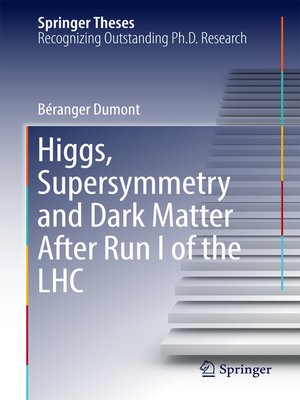Higgs, Supersymmetry and Dark Matter After Run I of the LHC
ebook ∣ Springer Theses
By Béranger Dumont

Sign up to save your library
With an OverDrive account, you can save your favorite libraries for at-a-glance information about availability. Find out more about OverDrive accounts.
Find this title in Libby, the library reading app by OverDrive.



Search for a digital library with this title
Title found at these libraries:
| Library Name | Distance |
|---|---|
| Loading... |
This work was nominated as an outstanding PhD thesis by the LPSC, Université Grenoble Alpes, France. The LHC Run 1 was a milestone in particle physics, leading to the discovery of the Higgs boson, the last missing piece of the so-called "Standard Model" (SM), and to important constraints on new physics, which challenge popular theories like weak-scale supersymmetry.
This thesis provides a detailed account of the legacy of the LHC Run 1 ≤¥regarding these aspects. First, the SM and the need for its extension are presented in a concise yet revealing way. Subsequently, the impact of the LHC Higgs results on scenarios of new physics is assessed in detail, including a careful discussion of the relevant uncertainties. Two approaches are considered: generic modifications of the Higgs couplings, possibly arising from extended Higgs sectors or higher-dimensional operators; and tests of specific new physics models. Lastly, the implications of the null results of the searches for new physics are discussed with a particular focus on supersymmetric dark matter candidates. Here as well, two approaches are presented: the "simplified models" approach, and recasting by event simulation. This thesis stands out for its educational approach, its clear language and the depth of the physics discussion. The methods and tools presented offer readers essential practical tools for future research.
This thesis provides a detailed account of the legacy of the LHC Run 1 ≤¥regarding these aspects. First, the SM and the need for its extension are presented in a concise yet revealing way. Subsequently, the impact of the LHC Higgs results on scenarios of new physics is assessed in detail, including a careful discussion of the relevant uncertainties. Two approaches are considered: generic modifications of the Higgs couplings, possibly arising from extended Higgs sectors or higher-dimensional operators; and tests of specific new physics models. Lastly, the implications of the null results of the searches for new physics are discussed with a particular focus on supersymmetric dark matter candidates. Here as well, two approaches are presented: the "simplified models" approach, and recasting by event simulation. This thesis stands out for its educational approach, its clear language and the depth of the physics discussion. The methods and tools presented offer readers essential practical tools for future research.







